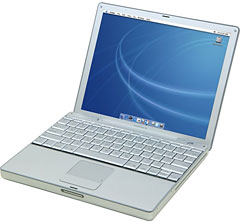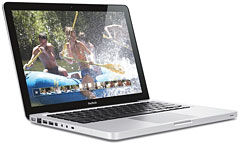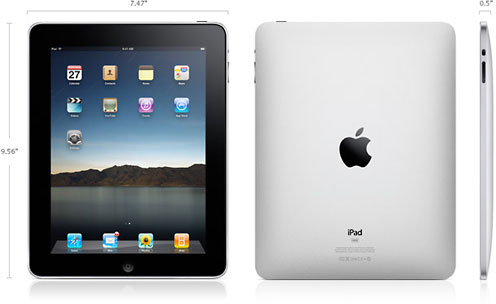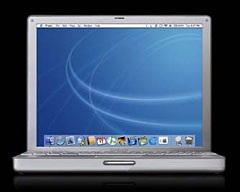Back in the early days of personal computing, PC Magazine
editor Bill Machrone proposed what he humbly referred to as "Machrone's
Law". He said, "The computer you really want always costs $5,000."
A decade later, desktop prices had dropped, so he amended it, noting
that the computer you really wanted was a laptop.

15" MacBook Pro with Retina Display
It's really hard to drop $5,000 on a personal computer these days -
even a laptop. Apple's new high-end MacBook Pro with Retina
Display starts at Cdn$2,229, and even maxing out the CPU, solid
state drive, and memory totals a "mere" $3,799.
In the real world, money is always an issue - at least for me and I
assume for you. And this means that when I'm looking for the computer
I'm going to get, rather than the one that I might want, there are
always tradeoffs.
Price is important, but it's not the only factor. Speed and power
are important - but once we pass the speed and power needed to get work
done, increased speed ad power become less important. Besides, these
days a fast network or Internet connection may count for more.
Similarly storage capacity. Yes, more is better, but I can make do
with less.
Portability/mobility counts for a lot with me. As many have found
with digital cameras, picture quality is often less important than
portability: You won't be able to take any pictures if you've left your
high quality, but heavy, camera at home. Hence the attraction of
relatively low-quality cameras built into mobile phones.

12" PowerBook G4
Recently, I bought a secondhand Mac PowerBook from LEM-writer Jason
Schrader - the 12" PowerBook G4 model that for a couple of years in the
mid-2000s was Apple's answer to the request for a laptop that was
relatively small, relatively powerful, and relatively affordable; it
remains among many longtime Mac owners' favourite models.
The 12" PowerBook
debuted in January 2003 with an 867 MHz G4 PowerPC CPU; the model I got
was one of the last version released, sporting a 1.5 GHz G4; that version was
sold between January 2005 and May 2006.
All the 12" PowerBooks feature 12.1" 1024 x 768 pixel displays - the
same resolution as the 9.7" displays on the original iPad (2010) and the (still for sale)
iPad 2. Mine has a 60 GB hard
drive (80 and 100 GB drives were also available) and a "SuperDrive", a
DVD reader/burner. The 12" PowerBooks all had 256 MB memory soldered in
plus an additional memory slot; adding a 1 GB memory module maxes the
RAM at 1.25 GB.
This model originally sold for $1,699 with the SuperDrive ($1,499
with a "Combo" drive that can read/write CDs but only read DVDs). I
paid under $200 for it.
Let's compare it to a few other Apple models of recent years, two
chosen because I happen to own them, and one because it's the currently
available Mac most like the 12" PowerBook.
12" PowerBook vs. 13" Aluminum MacBook
Apple released the 13"
Aluminum MacBook in late 2008. The next year, that model was
updated with a FireWire 800 port and SD Card slot
and re-christened the 13" MacBook Pro. With
various upgrades over the years, it remains in the product line
today.
I've got the original version with a 2.0 GHz Core 2 Duo processor
and removable battery - later models sealed in the battery, allowing
for a larger battery and longer battery life.

13" Aluminum MacBook
Both laptops weigh about the same amount - the PowerBook weighs in
at 4.6 lb., the MacBook at 4.5. Both have similar thickness and depth,
but the MacBook is nearly 2" wider to support its 13" 10:6 display.
Those 2" makes the PowerBook seem significantly more tote-able.
The MacBook's display is brighter than the PowerBook's and has 1280
x 800 resolution - note that while this is significantly more pixels in
the horizontal dimension, it's really not that much more vertically.
The result - the older PowerBook screen is more comparable to the
MacBook's than I had thought it would be.
(An aside: even the current 13" MacBook Pros have that same 1280 x
800 resolution, a big disappointment to me, especially since Apple
offers a higher resolution screen on its 13" MacBook Air.)
While both feature aluminum bodies, the MacBook's unibody
construction was carved out of a solid metal slab. The PowerBook is
built out of a bunch of thin panels held together with lots of teeny
screens. The result is that it gets dented out of shape and looks a bit
shopworn.
Battery life is similar between these two systems - both advertised
about five hours of battery life when new, although Apple claims seven
hours of battery life for the current 13" MacBook Pro. Both systems are
getting between 3 and 3-1/2 hours of life on their batteries now.
Both include wired ethernet and 802.11 WiFi. Although the MacBook's
networking (both wired and wireless) is faster in theory, in the real
world there's not much difference.
The MacBook does include significantly more storage - i.e. hard
drive space. It shipped with a 160 GB drive, which I replaced with a
512 GB model. Nice feature - replacing the hard drive in this model is
quick and easy; in subsequent 13" MacBook Pros, this has become much
more difficult. I could put a larger ATA hard drive in the PowerBook,
but that's also not one of Apple's more DIY-friendly designs.
The MacBook's 2.0 GHz dual-core Intel Core 2 Duo processor is newer,
faster, and more powerful than the PowerBook's 1.5 GHz PowerPC G4, and
that allows it to run more recent operating system versions and
software. More on that later.
Refurbished and used 13" aluminum MacBooks on eBay are currently priced in the Cdn$600 to
$780 range.
12" PowerBook vs. Original iPad
I've also got an original iPad. With a 12.1" screen compared to the
iPad's 9.7", the PowerBook is a bit longer and wider - but not all
that much. It's more than twice as thick (1.18" vs. 0.5") and nearly
three times as heavy (4.6 vs. 1.6 lb.). The iPad is a clear winner in
portability.

The original 9.7" Apple iPad
While both feature 1024 x 768 pixel screen resolutions, the iPad can
be used in your choice of portrait and landscape (vertical and
horizontal) orientations; holding it vertically is much nicer for
reading ebooks, for instance, which a horizontal orientation works well
for watching videos. This gives the iPad a usability edge as well.
My iPad is the 3G model (an added $130 cost plus a monthly cost for
mobile data service); this gives me Internet access away from WiFi
connections, something I find especially convenient since I'm not a
smartphone owner. Again, the iPad wins - though having a wired network
port on the PowerBook is handy from time to time. (A surprising number
of hotel rooms have wired networking but no WiFi.)
My iPad has 64 GB of storage, which is pretty comparable to the
PowerBook's 60 GB - note however, that the base iPad (even in the
newest model) starts at 16 GB, and a 32 GB model is also sold.
Neither the PowerBook nor my original iPad has a built-in camera. I
don't care. Battery life on the iPad - originally rated around 10 hours
and still around 8 hours, is significantly better than the
PowerBook.
On the other hand, the PowerBook has a built-in keyboard and
trackpad, an optical drive, and can run standard Mac software (at least
versions compatible with its older operating system). The iPad, running
iOS, runs lots and lots of apps - but for basic tasks like word
processing - or for printing, scanning, ripping music from CDs, and
many more - the PowerBook is superior.
While iPad prices start at Cdn$519, the additional storage added
$200 to the price, and the 3G networking added $130 for a total of
$849. Refurbished models like mine are being sold on eBay for $300.
12" PowerBook vs. Current 11" MacBook Air
If money were no object, I might spring for the system that occupies
the same niche in Apple's ecosystem today that the 12" PowerBook held
back in its day - the 11"
MacBook Air.
The current model was most recently updated in June 2012 with prices
starting at Cdn$1,029 (US$999) for a model with a 64 GB solid state
drive and a 1.7 GHz Intel Core i5 processor. (Larger SSDs are
available.)
If we can ignore that the dual-core processor is much more powerful
than the G4 and that the solid-state drive is much faster than the
PowerBook's conventional hard drive (and that the Air has 4 GB of
memory compared to the Power Book's 1.25 GB), these specs would seem
surprisingly similar.
The Air's 11" screen has 1366 x 768 pixel resolution - more
horizontally, but the same vertically as the PowerBook. Again, for
tasks involving vertical scrolling - like reading ebooks or long online
articles, these screens may not be that much different.
The Air is a bit wider and not quite as deep as the PowerBook - but
only half as thick at its thickest point (it tapers from 0.68" at the
back to a mere 0.11" at the front). And with a weight of 2.38 lb., it's
about half as heavy.
Like the 12" PowerBook when it was new, the battery on the Air is
rated for 5 hours of use.
No ethernet built into the Air, and no optical drive, though both
can be added externally.
The Air runs current Mac OS versions and can run current software;
the PowerBook is limited to older versions of OS X and many
software titles.
The 12" PowerBook Suffices

12" PowerBook G4
What about the operating system and software, then?
The original 2003 12" PowerBook originally shipped with OS X 10.2, with later models coming
with OS X 10.3 to 10.4.2.
For G4 PowerBooks with less than the maximum memory (768 MB is common),
OS X 10.4 Tiger offers the
best performance. I'm running OS X
10.5.8 Leopard on mine.
It's been awhile since I've spent much time with Leopard; going back
to it, I like it. It has a similar look to the more recent OS X 10.6 Snow Leopard and
includes features like Dashboard (which I ignore) and Time Machine
(which is handy).
As well, it is compatible with more relatively recent software than
Tiger - though in a few cases (such as the Google Chrome web browser),
software that claims to run with Leopard is only available for
Intel-powered systems - PowerPCs like mine need not apply.
There's a bonus to running Leopard (or 10.6 Snow Leopard on an Intel
system) rather than 10.7 Lion
or the just-released 10.8
Mountain Lion - the ability to run older OS X software created for
PowerPC processors - either natively or using Rosetta on Intel systems.
That has already come in handy for me a couple of times. As well, I was
able to use a version of Cisco's Cisco Connect utility that wouldn't
run on my MacBook's Lion system to manage my Linksys router.
(A bonus for staying with 10.4 Tiger - it's the last OS X version
that supports "Classic Mode", allowing the use of pre-OS X
applications).
While neither Firefox nor Chrome support PowerPC systems, I'm happy
with the TenFourFox browser,
a modern PowerPC version built on Firefox 10 code, thanks to Low End
Mac for Simon Royal's article on enabling Flash on
TenFourFox.
NeoOffice is a perfectly
good OpenOffice version for
PowerPC systems. All told, I don't feel like I'm missing anything
important to me - and by restoring the apps that were taken from me
when Lion dropped Rosetta support, I feel ahead.
In conclusion - it's worthwhile, but maybe just for now.
Looking Ahead
The 12" G4 PowerBook is a nice portable system that compares
reasonably well to my newer 13" aluminum MacBook. It's neither as fast
nor as lightweight as a new 11" MacBook Air, but it's also
significantly less expensive.
With its memory maxed out and running Leopard, it provides a
reasonable level of performance and a modern look and feel.
An iPad - even my original iPad - is significantly lighter and a
better ebook reader, but the PowerBook is better for typing, printing,
scanning, and other functions best done on a laptop. My iPad has 3G
connectivity, which is an important feature for me when I'm travelling
- but only a minority of iPads have mobile data capabilities.
As a result, I can happily recommend it to other users looking for a
mobile option on a restricted budget.
At least for now.
$200 has been the sweet spot for non-Apple tablets; HP and RIM, for
instance, only sold reasonable numbers of their respective tablet
models when they dropped the price to this level. Amazon's Kindle
(running a highly-modified version of Android) sold in large numbers at
this price point before Christmas, and before word of mouth of poor
performance had a chance to get out.
Google recently released a 7" Android tablet, the Nexus 7, for $199
(with 8 GB of storage) or $259 (with 16 GB); initial reviews have been
very positive, commenting on generally high build quality and fast
performance. I haven't tried one yet, but I do have one on order and
got an email today that it has (finally) shipped.
Rumours are that Apple may respond with a 7.8" iPad model - let's
fantasize a $299 price point.
While the 12" PowerBook won't magically become less useful if the
Nexus 7 or iPad Mini are successful and widely available, will anyone
really care if new, more mobile tablets become widespread and available
for not too much more money? 







